Related Research Articles
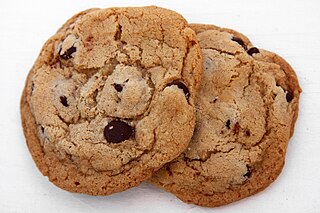
A cookie or biscuit is a baked snack or dessert that is typically small, flat, and sweet. It usually contains flour, sugar, egg, and some type of oil, fat, or butter. It may include other ingredients such as raisins, oats, chocolate chips, or nuts.
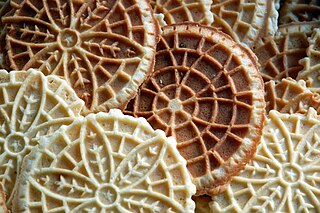
Pizzelle are Italian waffle cookies made with flour, eggs, sugar, butter or vegetable oil, and flavoring. Pizzelle are also known as ferratelle, nevole or catarrette in some parts of Abruzzo, as ferratelle in Lazio, and as ferratelle, cancelle or pizzelle in Molise.
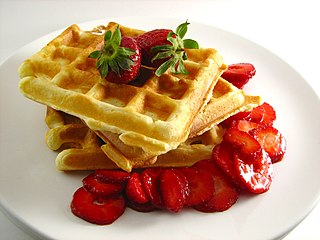
A waffle is a dish made from leavened batter or dough that is cooked between two plates that are patterned to give a characteristic size, shape, and surface impression. There are many variations based on the type of waffle iron and recipe used. Waffles are eaten throughout the world, particularly in Belgium, which has over a dozen regional varieties. Waffles may be made fresh or simply heated after having been commercially cooked and frozen.

A pancake, also known as a hotcake, griddlecake, or flapjack, is a flat cake, often thin and round, prepared from a starch-based batter that may contain eggs, milk, and butter, and then cooked on a hot surface such as a griddle or frying pan. It is a type of batter bread. Archaeological evidence suggests that pancakes were probably eaten in prehistoric societies.

Belgian cuisine is widely varied among regions, while also reflecting the cuisines of neighbouring France, Germany and the Netherlands. It is characterised by the combination of French cuisine with the more hearty Flemish fare. Outside the country, Belgium is best known for its chocolate, waffles, fries and beer.

A crêpe or crepe is a dish made from unleavened batter or dough that is cooked on a frying pan or a griddle. Crêpes are usually one of two varieties: sweet crêpes or savoury galettes. They are often served with a wide variety of fillings such as cheese, fruit, vegetables, meats, and a variety of spreads. Crêpes can also be flambéed, such as in crêpes Suzette.
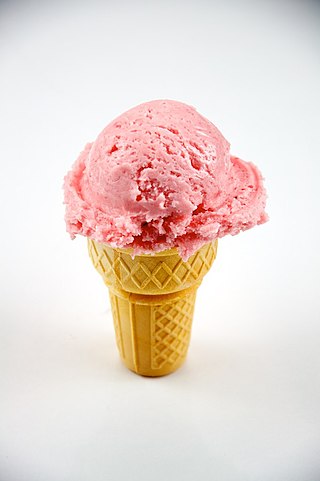
An ice cream cone (England) or poke (Ireland) is a brittle, cone-shaped pastry, usually made of a wafer similar in texture to a waffle, made so ice cream can be carried and eaten without a bowl or spoon. Many styles of cones are made, including pretzel cones, sugar-coated and chocolate-coated cones. The term ice cream cone can also refer, informally, to the cone with one or more scoops of ice cream on top.

A wafer is a crisp, often sweet, very thin, flat, light biscuit, often used to decorate ice cream, and also used as a garnish on some sweet dishes. They frequently have a waffle surface pattern but may also be patterned with insignia of the food's manufacturer or may be patternless. Some chocolate bars, such as Kit Kat and Coffee Crisp, are wafers with chocolate in and around them.

In English-speaking countries, Belgian waffles are a variety of waffle with a lighter batter, larger squares, and deeper pockets than American waffles. Belgian waffles were originally leavened with yeast, but baking powder is now often used. They are often eaten as a breakfast food; toppings vary from whipped cream, confectioners sugar, soft fruit, and chocolate spread, to syrup and butter or margarine. They may also be served with vanilla ice cream and fresh fruit as a dessert.
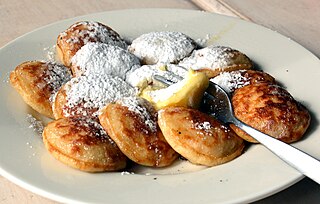
Poffertjes are traditional Dutch batter cakes. Resembling small, fluffy pancakes, they are made with yeast and buckwheat flour. Typically, poffertjes are sweet treats served with powdered sugar and butter, and sometimes syrup or advocaat. A savoury variant with gouda cheese is also made.

A waffle iron or waffle maker is a kitchen utensil used to cook waffles between two hinged metal plates. Both plates have gridded indentations to shape the waffle from the batter or dough placed between them. The plates are heated and the iron is closed while the waffle bakes. Waffles are a quick bread with a light and sweet flavor, similar to pancakes. Their appearance is much harder to achieve than a pancake's without a waffle iron. Similar technology is employed to bake wafers, and several other snacks including kue gapit, a waffle-shaped but crunchy Indonesian snack which can be made with both sweet and savoury flavours.

A stroopwafel is a thin, round cookie made from two layers of sweet baked dough held together by syrup filling. First made in the city of Gouda in South Holland, stroopwafels are a well-known Dutch treat popular throughout the Netherlands and abroad.

Christmas cookies or Christmas biscuits are traditionally sugar cookies or biscuits cut into various shapes related to Christmas.

Krumkake is a Norwegian cookie made of flour, butter, eggs, sugar, and cream.
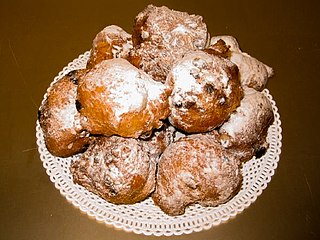
An oliebol is a Dutch beignet, a variety of doughnut or fried dough that is traditionally eaten on New Year's Eve. People often eat it with raisins baked inside and with powdered sugar on top. Another variation is made with apple inside instead of raisins. There are similar foods all around the world, for example Samoan Panikeke, eaten mostly with jam or butter on top.

Jumbles are simple butter cookies made with a basic recipe of flour, sugar, eggs, and butter. They can be flavored with vanilla, anise, caraway seed, or other flavoring like almond. They were formerly often made in the form of rings or rolls.
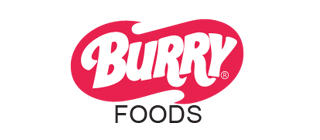
Burry's is a food manufacturer, founded as Burry's Biscuit Corporation by George W. Burry in 1888 in Elizabeth, New Jersey. It became a division of the Quaker Oats Company in 1962. The company was one of the manufacturers of Girl Scout cookies from 1936 until 1989.
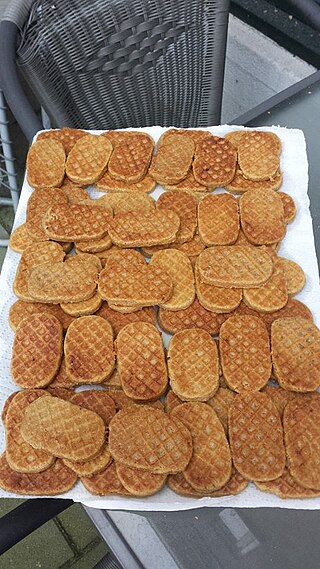
An ijzerkoekje is a soft cookie, traditionally eaten by Dutch fishermen, especially in Vlaardingen, one of the main harbours of the Netherlands during the 19th and 20th centuries. It is an oval cookie around 0.6-0.7 cm thick with a cinnamon 'creamy' taste. The cookies were invented in the city of Vlaardingen and are baked on a checkered iron plate, creating a characteristic waffle-like pattern, similar to stroopwafels.

Barquillo is a crispy rolled wafer pastry originating in Spain. It is made from the basic cookie ingredients of flour, sugar, egg whites and butter rolled out thinly and then shaped into a hollow cylinder or a cone. It was traditionally sold by roadside vendors known as barquilleros who carried a characteristic red roulette tin. It was introduced to Latin America and the Philippines during colonial times. In Spain and former Spanish colonies, barquillos are commonly regarded as a type of Christmas cookie. It is also popular during various fiestas. It spread to neighboring countries and today is extremely popular in East and Southeast Asian countries.

A lacquemant is a culinary specialty from the region of Liège, although it was created by Désiré Smidts at the Antwerp Fair, called Sinksenfoor where it is still eaten a lot. It is commonly eaten during the October fair in Liège.
References
- 1 2 3 4 5 6 Dansby, Angela (26 December 2023). "The Belgian waffle that brings New Year's luck". BBC . Retrieved 14 January 2025.
- ↑ Ysewijn, Regula (2023). Dark Rye and Honey Cake: Festival Baking from Belgium, the Heart of the Low Countries. Weldon Owen International. pp. 51–52. ISBN 978-1681888552.
- 1 2 3 4 5 6 "Hey, Good Lukken". Gazette van Detroit . 21 January 2010. p. 6. Retrieved 15 January 2025.
- 1 2 K. D. "Of 'Lukken' and 'Lukijzers'". Gazette van Detroit . No. 8 December 1988. p. 2. Retrieved 15 January 2025.
- 1 2 3 4 "Burgundian wafer irons". Musea Brugge . Retrieved 15 January 2025.
- ↑ K. D. "Speaking of 'Lukken'". Gazette van Detroit . p. 3. Retrieved 15 January 2025.
- ↑ Geldhof, Al. "The Lukken Lady". Gazette van Detroit . No. 23 January 2003. p. 6. Retrieved 15 January 2025.